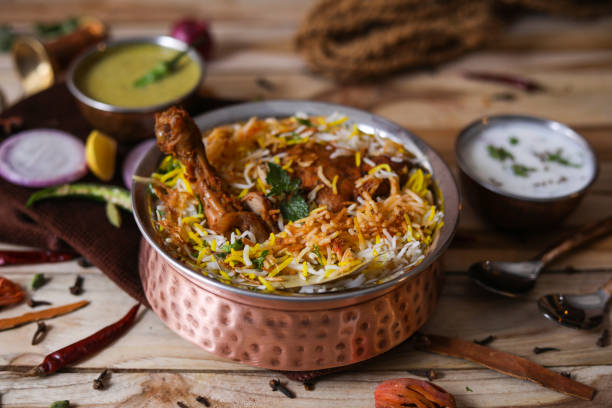Biryani, a flavorful and aromatic rice dish, is a cornerstone of South Asian cuisine. Its rich blend of spices, tender meat, and fragrant rice make it a beloved dish worldwide. While preparing biryani might seem daunting due to its numerous steps and the precise balancing of flavors, with the right tips and techniques, anyone can master this culinary art. Whether you are a seasoned chef or a novice cook, these tips will help you create a perfect Biryani Cooking tips that tantalizes the taste buds and leaves a lasting impression.
Choosing the Right Ingredients
To create exceptional Biryani, start with quality ingredients. Opt for long-grain Basmati rice known for its fragrance and non-sticky texture. Selecting the right cuts of meat, such as tender chicken thighs or succulent lamb, ensures the dish’s richness. The blend of spices, including saffron, cardamom, and cloves, adds depth and complexity to the flavor profile.
Preparing the Rice
Begin by washing the rice thoroughly to remove excess starch, which can make the grains sticky. Soaking the rice for at least 30 minutes before cooking helps achieve a perfect, fluffy texture. Cook the rice with care, ensuring each grain remains separate and fully cooked but not mushy.
Marinating the Meat
Marination is key to infusing the meat with the spices’ flavors and tenderizing it for a melt-in-your-mouth experience. Use a mix of yogurt, ginger-garlic paste, and a carefully balanced blend of Biryani spices. Allow the meat to marinate for at least a few hours, or ideally overnight, in the refrigerator for optimal results.
Layering and Assembly
Assembling Biryani is an art form. Layer the cooked rice and marinated meat in a heavy-bottomed vessel, alternating between layers to ensure even distribution of flavors. Drizzle saffron-infused milk and sprinkle fried onions between the layers to enhance the aroma and taste.
Cooking Methods
Traditionally, Biryani Cooking tips using the dum method, where the vessel is sealed with dough or foil to trap steam and flavors. This slow-cooking process allows the rice and meat to absorb the spices’ essence fully. Alternatively, pressure cooking offers a quicker method while still retaining Biryani’s essence.
Perfecting the Dum Process
Seal the vessel tightly to prevent steam from escaping during the dum process. Cook on low heat to allow the flavors to meld gradually. Adjust cooking times based on the type of meat used—chicken typically cooks faster than lamb or beef.
Garnishing and Serving
Before serving, garnish Biryani with fresh chopped cilantro, mint leaves, and additional fried onions for added crunch and flavor contrast. Serve hot with raita (yogurt sauce), pickle, and salad for a complete meal experience.
Troubleshooting Tips
If the Biryani turns out too dry, sprinkle a little warm milk over the layers before sealing for dum cooking. Adjust salt and spices to taste if the dish lacks flavor. Ensure the rice is not overcooked by checking for firmness before assembling.
Accompaniments
Biryani is often served with a side of raita (yogurt mixed with cucumber, mint, and spices), salad, and sometimes a boiled egg. These accompaniments balance the rich and spicy flavors of the biryani.
Practice Patience
Biryani is a dish that requires patience and attention to detail. Rushing through the process can lead to unevenly cooked rice or under-marinated meat. Take your time with each step to ensure a delicious end result.
Experiment and Personalize
While traditional biryani recipes are cherished, don’t hesitate to experiment with different ingredients and techniques. Try adding dried fruits like raisins or nuts for a sweet twist, or incorporate your favorite vegetables for a vegetarian version.
Conclusion
Mastering Biryani Cooking tips requires patience, attention to detail, and a love for culinary experimentation. By following these tips—from choosing the right ingredients to perfecting the dum process—you can create restaurant-quality Biryani that delights every palate. Mastering biryani takes practice and passion. By following these tips, you’ll be well on your way to creating a biryani that is not only delicious but also a true labor of love. Enjoy the process, and most importantly, enjoy the delightful flavors of your homemade biryani!
Frequently Asked Questions (FAQ)
1. What type of rice is best for biryani?
Long-grain basmati rice is the best choice for biryani due to its fragrant aroma and fluffy texture. It helps in achieving the perfect separation of grains.
2. How long should I marinate the meat for biryani?
Marinate the meat for at least a few hours to overnight. This allows the spices to penetrate the meat thoroughly, making it flavorful and tender.
3. Can I make vegetarian biryani?
Yes, you can make vegetarian biryani by replacing meat with vegetables like potatoes, carrots, peas, and paneer. The preparation process remains largely the same.
4. What is the dum cooking method?
The dum cooking method involves sealing the pot with a tight-fitting lid or dough and cooking the biryani on low heat. This traps the steam inside, allowing the flavors to meld together and cook evenly.
5. How do I prevent the rice from becoming mushy?
Rinse the rice thoroughly to remove excess starch and soak it for at least 30 minutes before cooking. Cook the rice until it is 70-80% done before layering it in the biryani pot to avoid overcooking.





